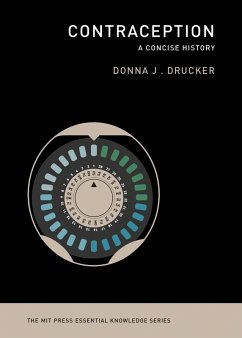The development, manufacturing, and use of contraceptive methods from the late nineteenth century to the present, viewed from the perspective of reproductive justice.
The beginning of the modern contraceptive era began in 1882, when Dr. Aletta Jacobs opened the first birth control clinic in Amsterdam. The founding of this facility, and the clinical provision of contraception that it enabled, marked the moment when physicians started to take the prevention of pregnancy seriously as a medical concern. In this volume in the MIT Press Essential Knowledge series, Donna Drucker traces the history of modern contraception, outlining the development, manufacturing, and use of contraceptive methods from the opening of Dr. Jacobs's clinic to the present. Drucker approaches the subject from the perspective of reproductive justice: the right to have a child, the right not to have a child, and the right to parent children safely and healthily.
Drucker describes contraceptive methods available before the pill, including the diaphragm (dispensed at the Jacobs clinic) and condom, spermicidal jellies, and periodic abstinences. She looks at the development and dissemination of the pill and its chemical descendants; describes technological developments in such non-hormonal contraceptives as the cervical cap and timing methods (including the "rhythm method” favored by the Roman Catholic church); and explains the concept of reproductive justice. Finally, Drucker considers the future of contraception—the adaptations of existing methods, new forms of distribution, and ongoing efforts needed to support contraceptive access worldwide.
The beginning of the modern contraceptive era began in 1882, when Dr. Aletta Jacobs opened the first birth control clinic in Amsterdam. The founding of this facility, and the clinical provision of contraception that it enabled, marked the moment when physicians started to take the prevention of pregnancy seriously as a medical concern. In this volume in the MIT Press Essential Knowledge series, Donna Drucker traces the history of modern contraception, outlining the development, manufacturing, and use of contraceptive methods from the opening of Dr. Jacobs's clinic to the present. Drucker approaches the subject from the perspective of reproductive justice: the right to have a child, the right not to have a child, and the right to parent children safely and healthily.
Drucker describes contraceptive methods available before the pill, including the diaphragm (dispensed at the Jacobs clinic) and condom, spermicidal jellies, and periodic abstinences. She looks at the development and dissemination of the pill and its chemical descendants; describes technological developments in such non-hormonal contraceptives as the cervical cap and timing methods (including the "rhythm method” favored by the Roman Catholic church); and explains the concept of reproductive justice. Finally, Drucker considers the future of contraception—the adaptations of existing methods, new forms of distribution, and ongoing efforts needed to support contraceptive access worldwide.
Dieser Download kann aus rechtlichen Gründen nur mit Rechnungsadresse in A, B, BG, CY, CZ, D, DK, EW, E, FIN, F, GR, HR, H, IRL, I, LT, L, LR, M, NL, PL, P, R, S, SLO, SK ausgeliefert werden.
"Drucker uses the powerful lens of reproductive justice to rethink the history of contraception. A concept developed by feminist thinkers and activists of colour, the history of which Drucker examines in detail in the fifth chapter, reproductive justice requires consideration of local and global stratifications and gendered, racialised, and classed power imbalances relating to reproduction in three key areas: the right to have a child, the right to not have a child, and the right to parent children safely and healthily Contraception: A Concise History provides an excellent introduction to the history of contraception. The book is well-written and well organised, persuasively argued and innovative in using the reproductive justice perspective to revisit some well-known milestones in the history of contraception and to shed light on less-known ones, particularly in the history of spermicides."
Metascience
Metascience









